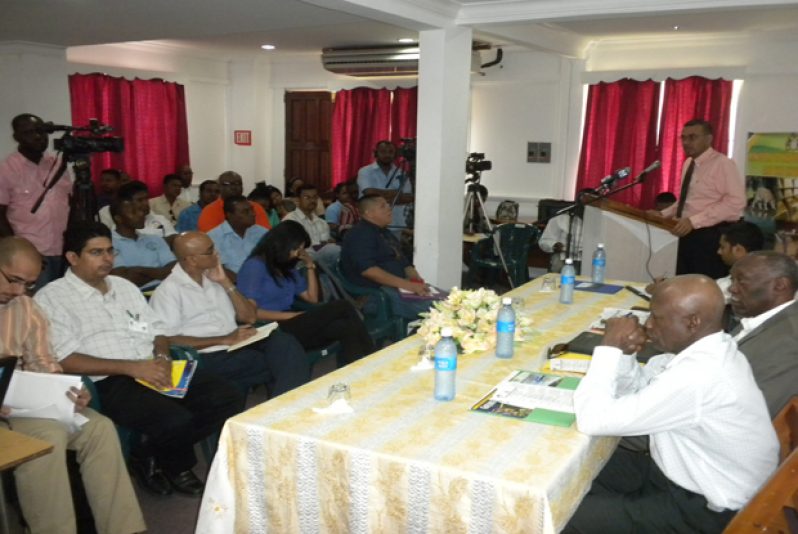PULL QUOTE: ‘With respect to technological support for field staff, the GGMC is currently working on its capability to process satellite images so that operatives can get early warning of illegal mining and illegal forestry’
THE Ministry of Natural Resources and the Environment (MNR&E) is reviewing a range of technology which can be utilized in early detection of illegal mining and forestry activity in remote areas in the hinterland.

The options include use of satellite imagery, the use of cameras on private and commercial aircraft crisscrossing the hinterland and even the use of drones, unmanned aircraft, for early detection and effective corrective action.
Minister of Natural Resources and Environment Mr. Robert Persaud disclosed this while lamenting the current inability of regulatory agencies to effectively stamp out the illegal exploitation of the country’s natural resources.
During an address to stakeholders at an environmental stakeholders workshop at the Cheddi Jagan Research Centre, Kingston, Georgetown on Friday, he stressed the need for the MNR&E and all other stakeholders to ramp up the activities needed to ensure that illegal activities in the extractive sector are eliminated in the interest of preservation of the Guyanese patrimony and the economic future of the country
He stressed that Guyanese must be aware that use of the natural resources has enabled the country to survive the economic difficulties and minimize the hardships of the economic crisis.
“We cannot ignore that our prosperity, our survival as a country economically and socially depends on how well we use our natural resources.”
He noted that he was happy with the wide range of legislation and policies which protect the environment.
“We in Guyana have the most comprehensive legislative framework in terms of managing the environment. From the Environmental Protection Agency (EPA) to the Guyana Geology and Mines Commission (GGMC), the Guyana Forestry Commission (GFC) to the various other agencies which look at regulations for environmental issues, including the Protected Areas Commission (PAC), the Wildlife Conservation and Management systems, the comprehensive wildlife bills that will be going to the National Assembly soon, I think we have been proactive and we have done very well.”
He said that the area of weakness, however, is in the institutions which have the job of conservation and preservation of the environment.
He said: “We have had some good cases but ensuring compliance in the natural resources sector is an area in which we have been weak in terms of consistency. Our agencies have not been able to fully ensure that there is compliance. We recognize that there is a weakness in terms of consistent monitoring and in ensuring compliance.”
He said that with respect to the issue of compliance with forestry regulations there had been some mixed results but greater diligence is needed in terms of ensuring that operators both at the community level as well as concession holders are responsive to regulations and are responsible in their extractions.
In view of this, he said, he was appealing to all stakeholders, including residents of hinterland communities, to support the regulators such as the GGMC and the GFC to become more efficient in terms of monitoring issues such as illegal forestry, pollution of waterways, land degradation and inadequate work on land reclamation and rehabilitation after mining.
All concerned, he stressed, should seek to involve communities in becoming key players in managing the environmental impacts of activities which involve the utilization of the forest for biodiversity activities and for the extractive purposes such as mining and forestry and not merely be spectators, he said.
ENVIRONMENTAL BONDS
In connection with the issue of land reclamation after mining, he disclosed that local gold and diamond miners will soon be required to lodge more money with the GGMC for the purpose of Environmental Bonds which aim at ensuring the successful rehabilitation and reclamation of mined-out areas.
According to the mining regulations, every large and medium-scale prospecting and mining licence and holder must lodge an Environmental Bond in the form of money in favour of the GGMC for the restoration of mined-out lands to a safe and usable form after mining is completed.
If after the mining activity the area is not restored to the satisfaction of the GGMC, the GGMC will give the miner three months to restore the environment of the mined-out area.
If the miner fails to do this, the GGMC will use part or all of the Environmental Bond to restore the environment.
With respect to technological support for field staff, he said that the GGMC is currently working on its capability to process satellite images so that operatives can get early warning of illegal mining and illegal forestry.
He said that drones have been used to monitor forests in some countries and this is an area the ministry will want to explore in terms of knowing what is taking place in remote areas.
The ministry will also take steps to further strengthen manpower and the skills of staffers in the regulatory agencies.
He said that the challenges in managing the environment in an expanding extractive sector are many. However, he urged all stakeholders to assist in bringing harmony and balance in natural resources development and the environment. Minister Persaud also called on them to assist with helping the country to do so and at the same time stay on track in terms of developing a green economy consistent with the Low Carbon Development Strategy (LCDS).
Written By Clifford Stanley



.jpg)








